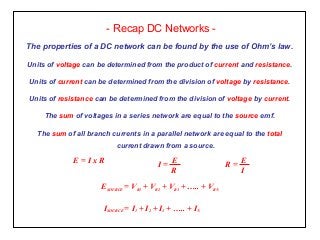
Elect principles 2 dc series networks recap
- 1. - Recap DC Networks - The properties of a DC network can be found by the use of Ohm’s law. Units of voltage can be determined from the product of current and resistance. Units of current can be determined from the division of voltage by resistance. Units of resistance can be determined from the division of voltage by current. The sum of voltages in a series network are equal to the source emf. The sum of all branch currents in a parallel network are equal to the total current drawn from a source. I = E R R = E I E = I x R ESOURCE = VR1 + VR2 + VR3 + ….. + VRN ISOURCE = I1 + I2 + I3 + ….. + IN
- 2. - Recap Series Resistance Networks - Activity 1. What current will flow in a series circuit comprising three resistances 10Ω, 30Ω, 20Ω and a source emf of 40V. 2. Three resistances are connected in series. If the voltage across each is 5V, 2V and 10V and the current is measured as 2 amps determine the value of each resistance and the source emf. 3. Three resistances are connected in series. The first resistance is 2 ohms the voltage across this was found to be 10 volts. A second resistance was marked up as being 5 ohms and the source emf is 50 volts. Determine the value of the third resistance and check your results. It is a good idea to sketch these circuits before starting to calculate your results.
- 3. DC Networks Derive and magnitude of the current IT for the circuit shown, and individual currents I1, I2 and I3. Where E = 50V, R1 = 10Ω, R2 = 15Ω, R3 = 5Ω, R4 = 10Ω and R5 = 20Ω I1 IT R1 R2 R3 R4 R5 I3I2 E
- 4. DC Networks Activity Derive the value of supply voltage VB, IT, I1 and I2 if; VR1 = 12V, R1 = 6Ω, R2 = 4Ω and R3 = 8Ω I1 IT R1 R3 I2 VB R2 VR1
- 5. DC Networks Activity Determine the value of R3 and currents IT, I1 and I2 if, VB = 50V, E = 30V, R1 = 2Ω, R2 = 6Ω Also determine the total power and the power dissipated in each resistance. I2 R V2 R Power P = V I or or Remember IT R1 E VB I1 R2 R3 I2
- 6. DC Networks Determine the value of R2 and IT, for the circuit shown and the total power drawn from the supply. IT R1 R2 R3 40ΩE = 200V 120V 0.2A 80V 0.8A
- 7. DC Networks Determine the value of R2 and IT, for the circuit shown and the total power drawn from the supply. IT R1 R2 R3 40ΩE = 200V 120V 0.2A 80V 0.8A